
BIOS and Overclocking …
Get fast to the right UEFI settings …
BIOS and Overclocking
UEFI BIOS Update
ASRock X99 Professional Gaming i7 overclocking
ASRock X99 Professional Gaming i7 memory settings
ASRock X99 Professional Gaming i7 voltage settings
Overclock even easier
BIOS undervolting
Fan control
BIOS and overclocking …
Let us continue with the BIOS / UEFI Setup options and the UEFI overclocking. By pressing F2 or Del during PC boot, you get access to the UEFI Setup.
The ASRock X99 WS-E10G UEFI has a graphical interface that allows intuitive operation by mouse, or still can be operated with a keyboard.
For beginners there is the ASRock EZ Mode – Easy Mode, an entry page with most important information and is still not looking overloaded.
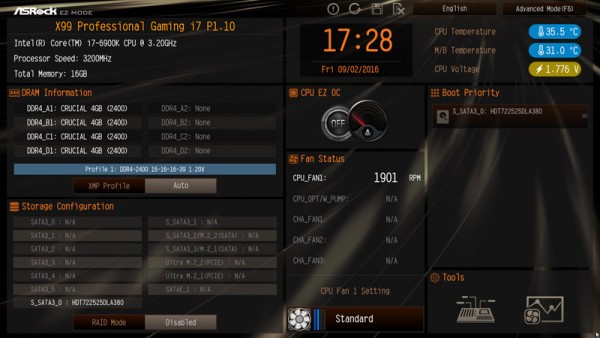
It offers basic information such as time, date, CPU temperature, motherboard temperature, CPU voltage, first details about the hardware, fan speeds, as well as an adjustment possibility of the fan with one click.
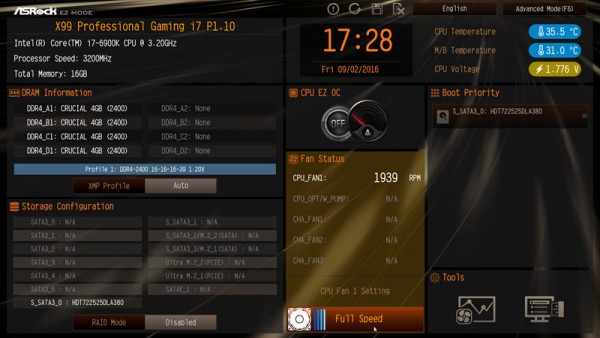
As seen in the latest X99 Taichi Motherboard Review, some applications were grouped together in one tools page.
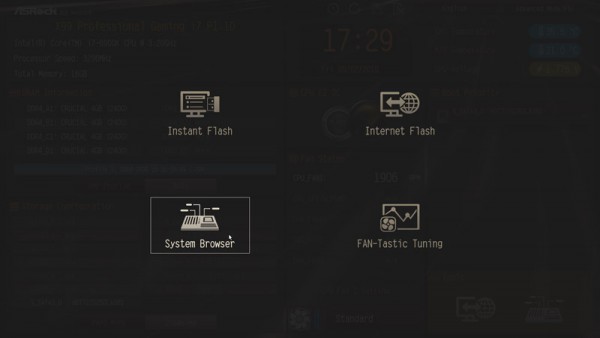
If you want to view more details about the installed hardware, there is also the System Browser view, to watch graphically which components are installed in the PC.
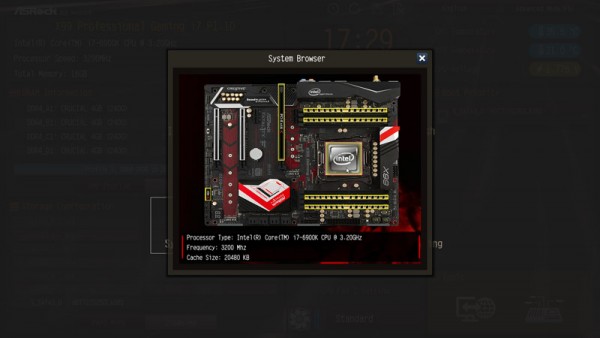
You can get more information with a click on the component and with a click on the I/O panel you can see the installed devices of each port.
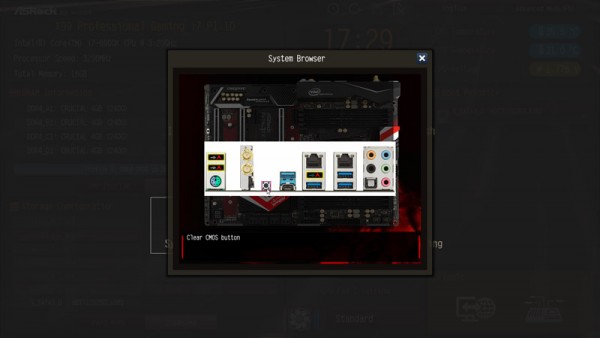
Of course, you can also set the time and date over the EZ menu.
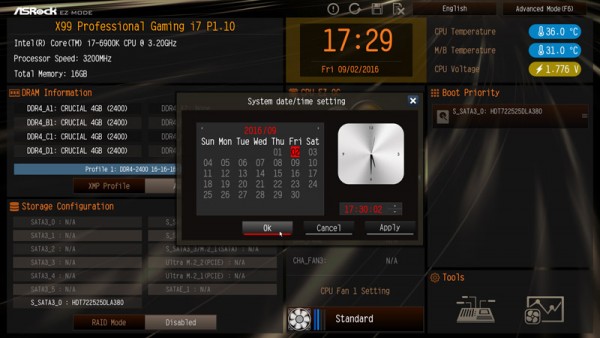
More functions can be activated with keyboard shortcuts or using the F-keys.
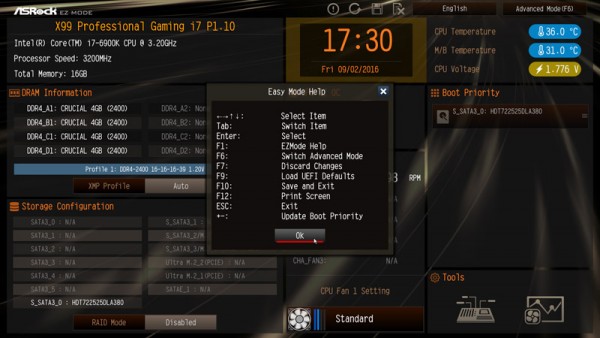
With the F6 key you can get back to the ASRock advanced mode after a short confirmation, which you can also set as standard option. Overclockers should start with the Advanced mode or directly with the Tweaker menu or the favorite menu.
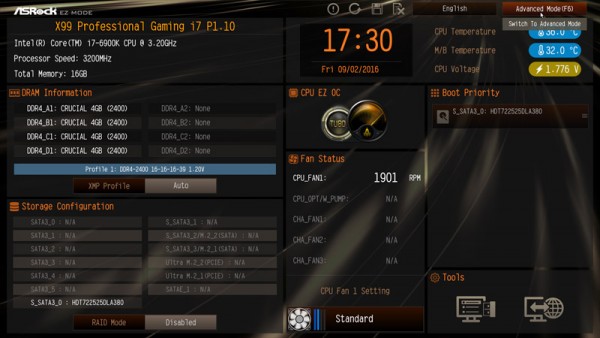
In Advanced Mode you can see at the first screen the UEFI version, the CPU used, the installed DDR4 memory with quad channel support, a language selection and the My Favorite menu item.
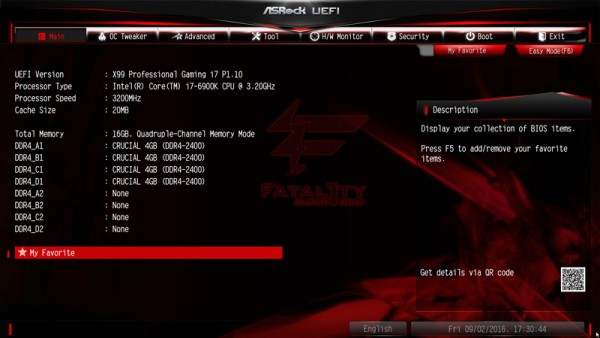
The My Favorite feature is very useful, because you can add here often needed menu items. You start with a blank page – incidentally it’s also blank after each BIOS update. Simply select the desired menu item, then press F5 and the feature is contained in the my favorite overview page. Here you can see a selection of possible favorites.
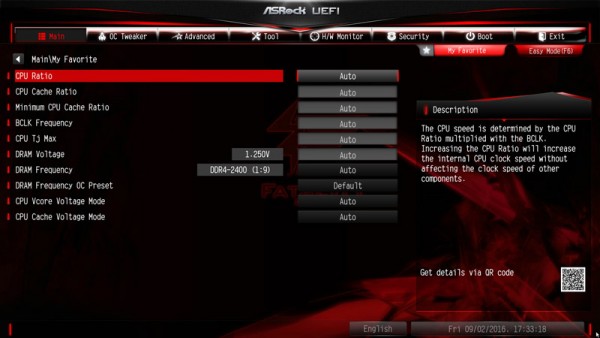
The X99 motherboard has a selection to view the UEFI in Full HD and also offers the Active Page on Entry selection, where you can decide which UEFI page you want to see when you enter the UEFI Setup. This is very helpful mainly for overclocking, since one have to enter the second OC Tweaker menu very often to find the best OC settings. Or you just add all necessary points to the My Favorite overview and start directly to the My Favorite overview page. At the ASRock X99 Professional Gaming i7 you find the Active Page on Entry option and the Full HD UEFI selection now in Advanced.
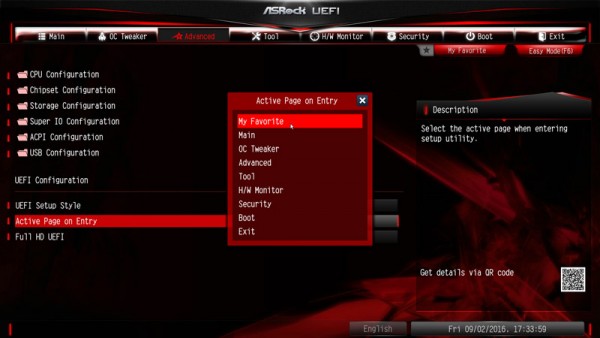
UEFI BIOS Update …
Before we begin with the UEFI settings, we first update the UEFI BIOS to the latest version. To flash the UEFI update ASRock offers some possibilities, e.g. the very simple Instant Flash or the ASRock Internet Flash with a direct connection to the Internet.
By the so-called ASRock Instant Flash option in the tool screen or via F6 during PC start you get into the ASRock Instant Flash utility. You can easily flash a previously downloaded ASRock BIOS without a boot CD or similar by simply starting the ASRock Instant Flash utility. Just select the BIOS Flash ROM from the desired drive, like an USB stick.
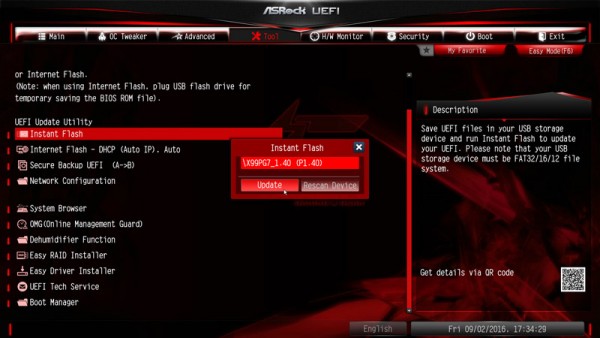
The board is supplied with the BIOS P1.10. At testing date, the UEFI BIOS version P1.40 was available as latest download, which we updated of course immediately. Now you confirm the UEFI update. And already the new UEFI will be updated.
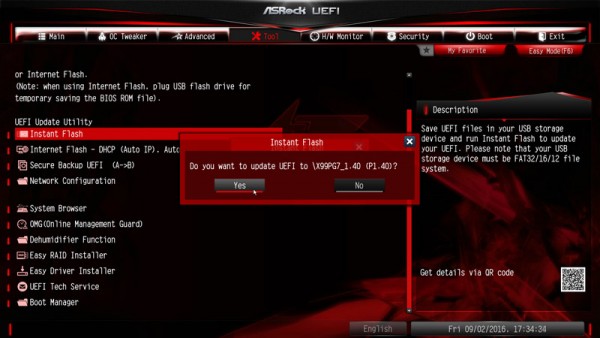
The new UEFI version is available after a restart …
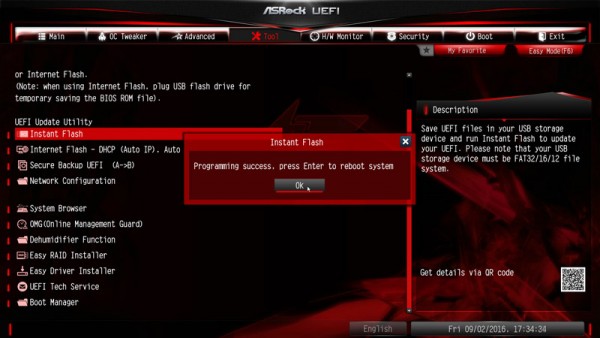
… and can be checked on the entry page.
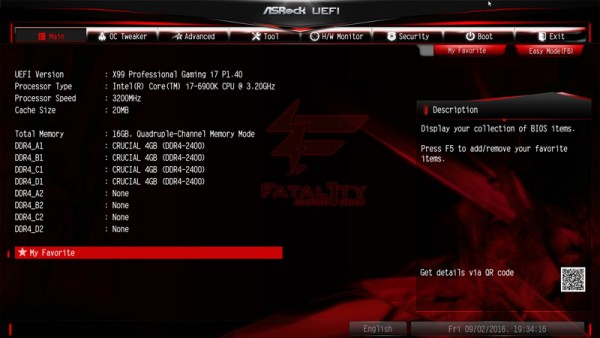
Now unfortunately the my favorite page is empty again, this could be improved a bit.
If you need technical UEFI support, you can now even contact ASRock Tech Service over the UEFI setup and a network connection.
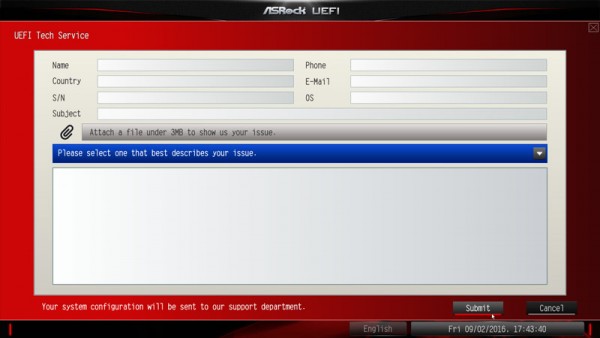
On the tool page, you can find by the way a system browser view, where you can graphically see all installed components.
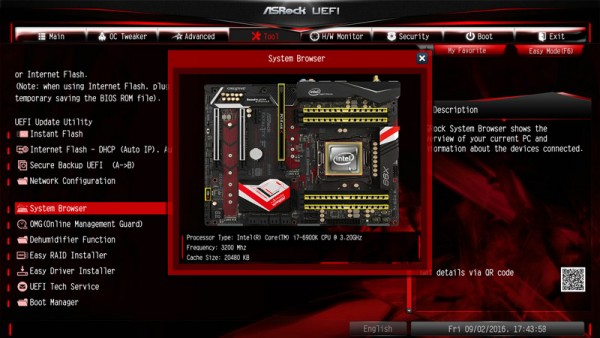
With the OMG – Online Management Guard, you can define the times and days for the Internet access. This is for example useful for parents who like to specify a fixed Internet time for their children and want to block access with a password secure in UEFI BIOS, or for companies that allow Internet access for their employees only during lunch or after regular working hours.
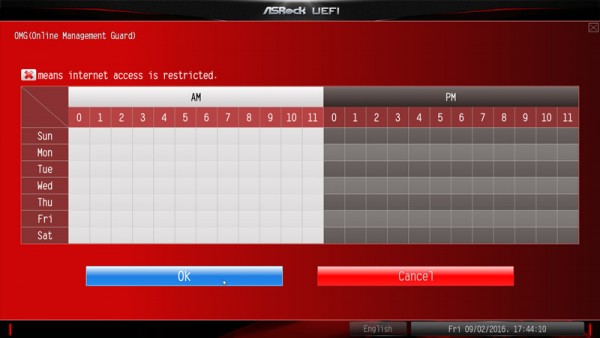
ASRock X99 Professional Gaming i7 overclocking …
ASRock split the OC-Tweaker settings in CPU Configuration, DRAM Configuration, FIVR Configuration and Voltage Configuration.
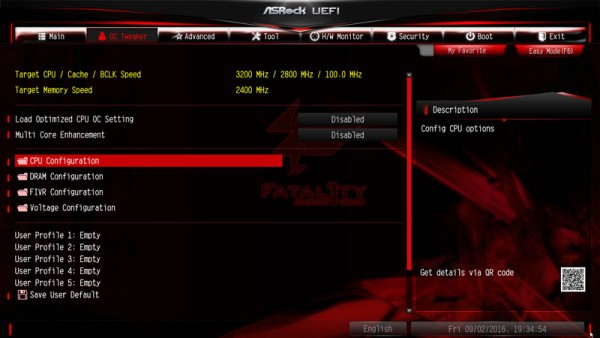
A look at the options in CPU configuration shows many OC options for the Intel LGA2011-3 CPU overclocking, now even with Intel Turbo Boost Max Technology 3.0 option.
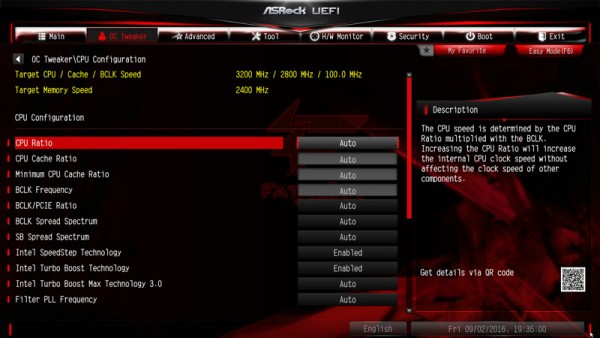
The corresponding Intel Turbo Boost 3.0 software is supplied from ASRock.
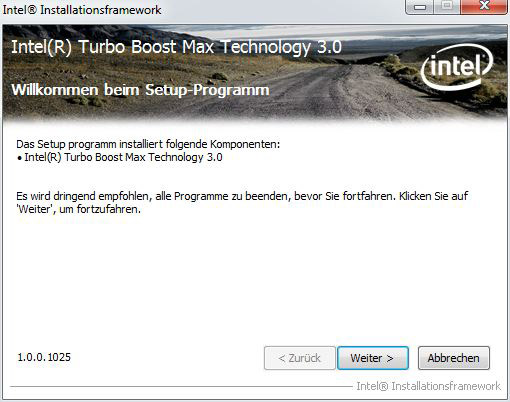
One can set the BCLK/PCIE frequency in this UEFI menu from 96 MHz to 300 MHz. This frequency is very important for a lot of frequency values also with Intel LGA2011-3 processors, which can get quickly too high. For this reason, you should carefully increase the BCLK host clock and also adjust the BCLK ratio to 125 MHz, 167 MHz or even higher.
In our tests the board at 1.67 BCLK ratio could be stable overclocked to 173.14 MHz BCLK!
The Intel “K” CPUs have an unlocked multiplier, so one can overclock the CPU frequency very extensively over the CPU multiplier. With a 6900K CPU (default clock 3200 MHz with a CPU ratio of 32x), the ASRock X99 Professional Gaming i7 motherboard offered a multiplier range from 12x to 120x.
ASRock X99 Professional Gaming i7 memory settings …
Let us take a look at the DRAM configuration.
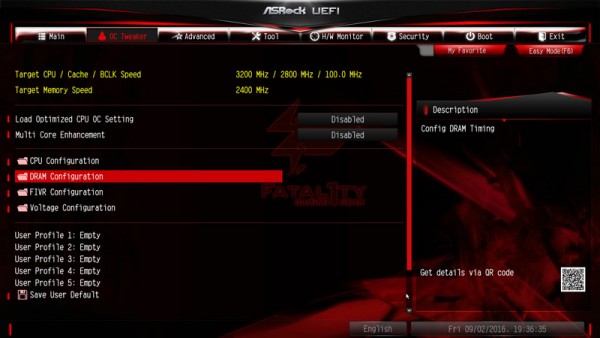
In the DRAM configuration menu you will find among others the selection, whether to the DDR4 reference clock 100 MHz or 133 MHz and how high you like to adjust the DDR4 RAM voltage.
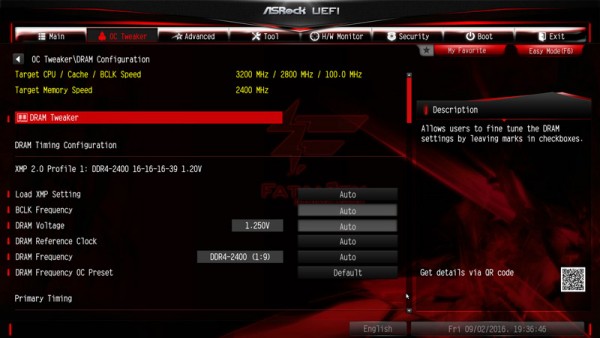
For DDR4 memory, there are settings like e.g. the memory frequency from DDR4-800 up to DDR4-4000.
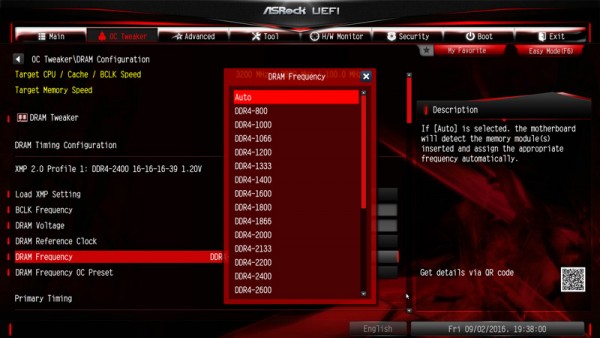
Here you see the DDR4 frequency selection up to DDR4-4000.
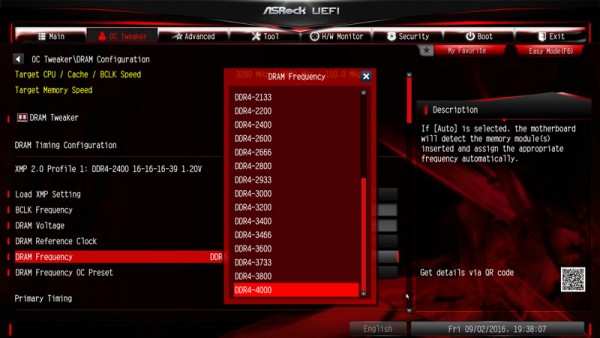
ASRock has more very special to offer to overclock DRAM more easily. The so called DRAM Frequency OC Preset values. With this DDR4 OC preset it is possible for example to overclock to DDR4-4133 by automatic BCLK increasing.
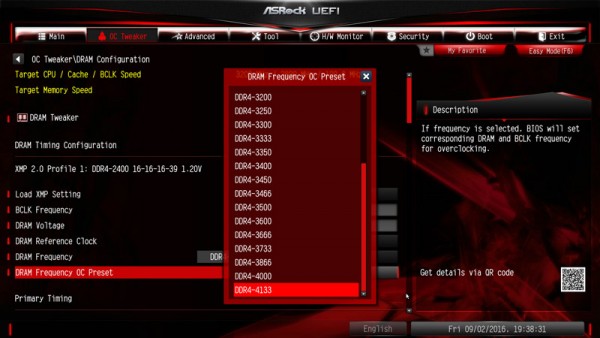
With manual BCLK overclocking and the correct RAM modules, significantly higher memory clock rates are possible. The frequency of all memory modules is calculated and displayed after changing the reference clock to make it much easier adjusting to the right RAM frequency.
Optionally you can manually adjust all DDR4 timings:
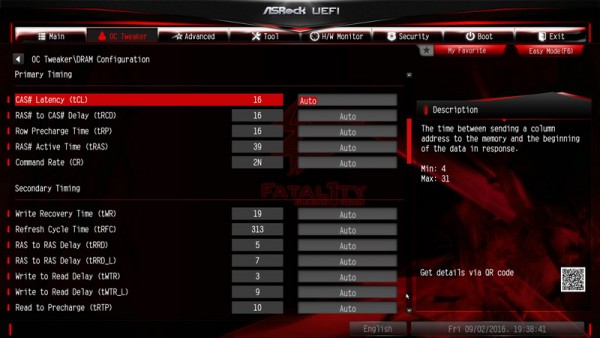
Furthermore the ASRock X99 Professional Gaming i7 offers a DRAM Tweaker menu and an overview of all SPD and XMP values to select them directly.
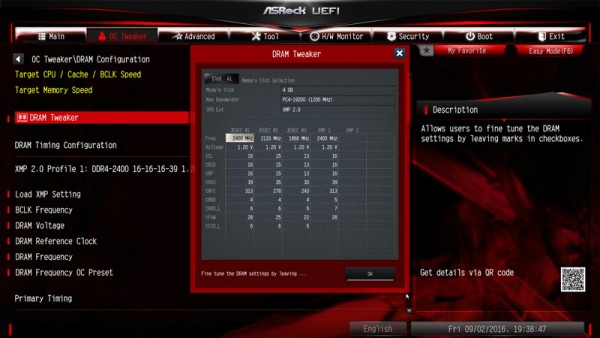
Thanks to XMP support, XMP memory modules can be set correctly with one mouse click in the UEFI by selecting the desired profile in the DRAM configuration. If you have memory modules with XMP profile, you can load the values directly from the XMP EEPROM.
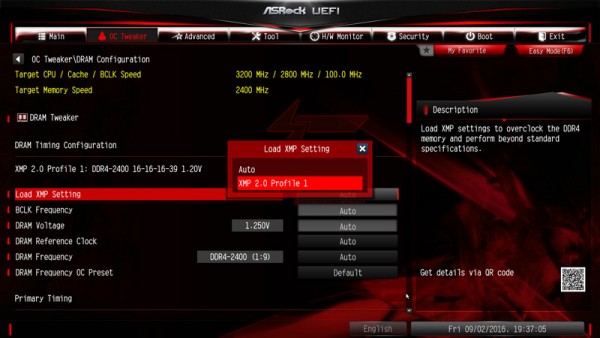
ASRock X99 Professional Gaming i7 voltage settings …
Now we come to the voltage settings that can be adjusted in the UEFI.
For X99 the voltage settings are separated in FIVR Configuration and Voltage Configuration.
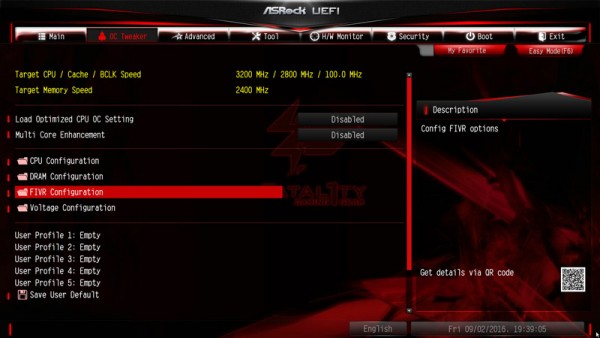
Here are the settings for the FIVR configuration:
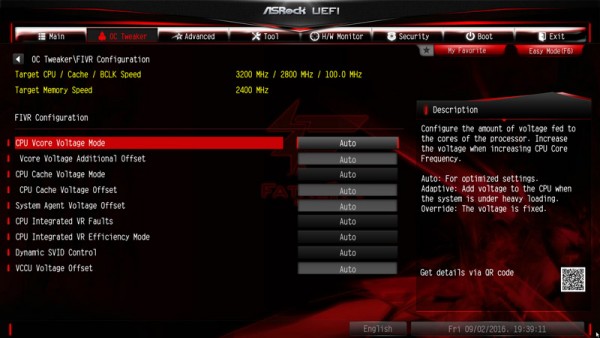
All other voltages can be found in voltage configuration.
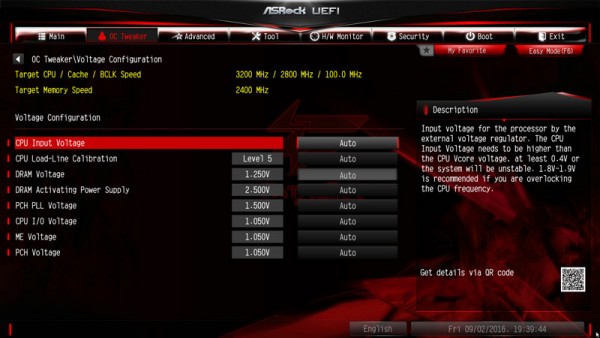
The motherboard offers many voltage settings, like for example a VCore selection with the Intel Core i7-6900K Test CPU from 0.800 Volt up to 2.000 Volt and -0.500V to +0.500V offset, CPU Cache Voltage from 0.800 Volt to 2.000 Volt and -0.500V to +0.500V Offset, CPU Input Voltage from 1.200V to 2.300V and -0.600V to +0.400V Offset, CPU IO Voltage from 0.900 to 1.500 Volt, PCH (Chipset) voltage from 0.900 to 1.500 Volt, PCH PLL Voltage from 1.500 to 1.750 Volt, ME Voltage 0.900 to 1.500 Volt, System Agent Voltage Offset from -0.300 to +0.600 Volt, VCCU Voltage Offset -0.500 to +0.500V, Primary Plane Current Limit, Short Duration Power Limit, Long Duration Power Limit, CPU Load Line Calibration from 1 to 5, DRAM Activation Power Supply from 2.400V to 3.000V and more voltage boost settings to have more room for detailed overclocking.
The DDR4 voltage could be increased as seen above, between 1.000 and 2.235 Volt, which is an awesome DDR4 memory voltage range for high overclocking or low undervolting.
ASRock X99 Professional Gaming i7 even easier overclocking …
If you do not like to get deeper inside of overclocking, you can overclock either by the Load 4 GHz and XMP OC Setting or by the Load Optimized CPU OC Settings, to try overclocking with predefined OC settings. It can increase the system performance automatically by overclocking in different Turbo steps – at least with some luck and if it is possible with your processor. Simply select the desired Optimized CPU OC setting, then some components and the CPU are overclocked, e.g. to Turbo 3.8 GHz, Turbo 4.0 GHz or Turbo 4.2 GHz, overclocking could not be easier!
Here you can see the Load Optimized CPU OC Settings for the Intel Broadwell-E 6900K CPU:
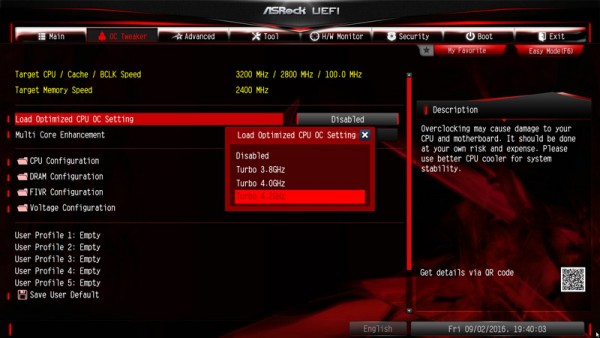
Higher overclocking should set manually for each value, to be able adjusting all values in detail for the installed hardware. We give you overclocking help in our PC Forum.
Once the desired settings are found, you can save up to five different OC Tweaker BIOS settings with names in the UEFI. For example, you can save balanced BIOS settings, overclocking settings and undervolting settings or Office and Gaming settings in an user profile of the UEFI to load them very quickly at any time.
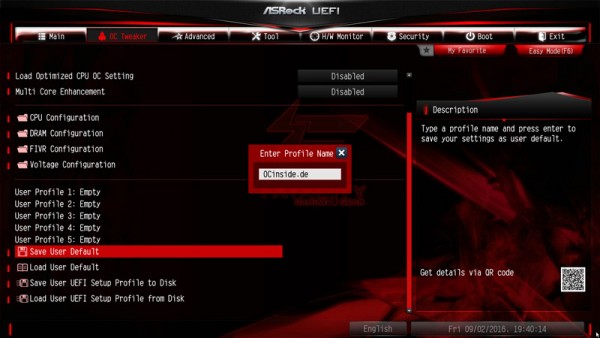
The boot failure guard was also tested and started the PC even at too high overclocking settings without Clear CMOS at default frequencies. If it accidentally succeeds that the PC fails to boot, you can also press the Clear CMOS button and the stored values in the user profiles fortunately remain to load them quickly.
Also interesting is the new “Save User UEFI Setup Profile to Disk” option. Just click it to save your own UEFI settings on the hard drive or an USB stick.
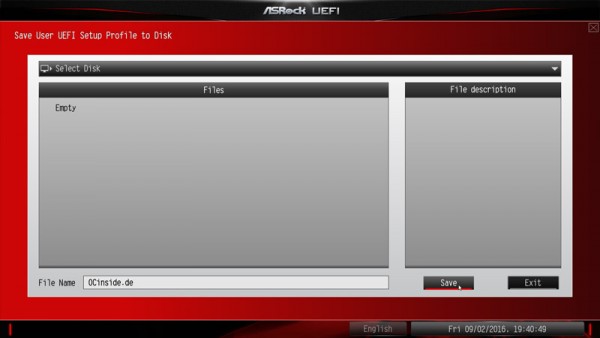
BIOS Undervolting …
The downclocking or underclocking is also tested in this review. It was possible to lower the Intel Core-i7-6900K CPU multiplier over the BIOS to 12x to underclock the processor with 100 MHz BCLK to approx. 1200 MHz. Of course, underclocking is like overclocking outside of the manufacturers specification, so it is necessary to have some luck. ASRock gives several options for easy PC underclocking / downclocking.
There are much more UEFI settings like CPU, Chipset, Storage, Super IO, ACPI and USB Configuration setup.
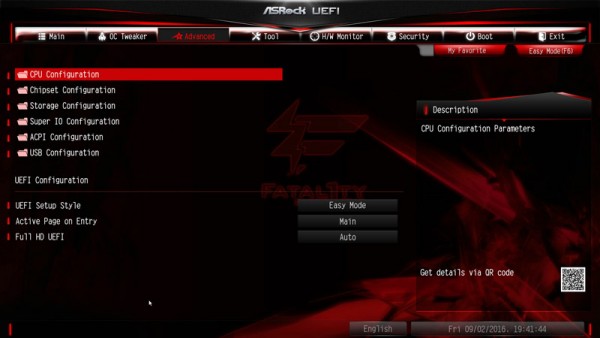
If you want to save energy consumption of the Intel Core i7 PC, you should check all settings in the CPU configuration menu under Advanced.
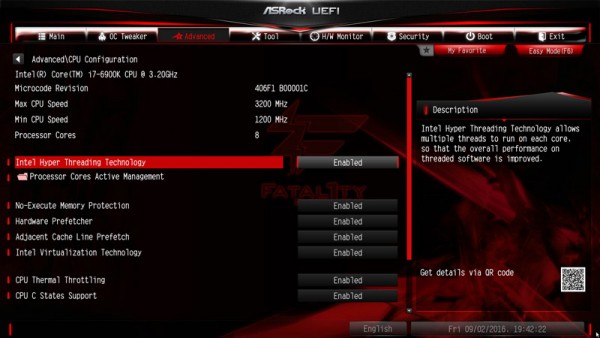
But also settings in Advanced Chipset Configuration are important.
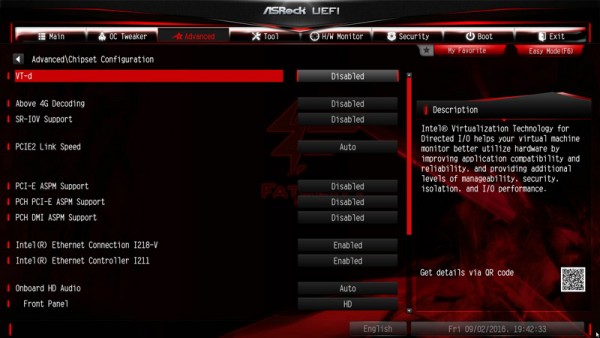
Who rather would like to overclock in Windows, can make many of the above voltage and frequency settings even with the ASRock F-Stream tool.
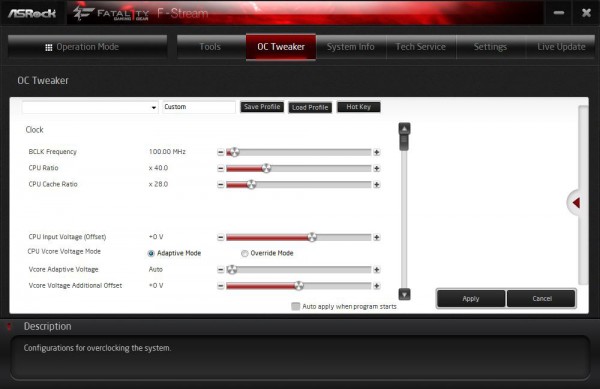
Fan control …
The UEFI Setup of the passive cooled X99 Professional Gaming i7 motherboard offers extensive temperature fan control options for 4-pin or 3-pin CPU fans. The settings for the fan controller can be found in H/W Monitor directly below the temperature und voltage display.
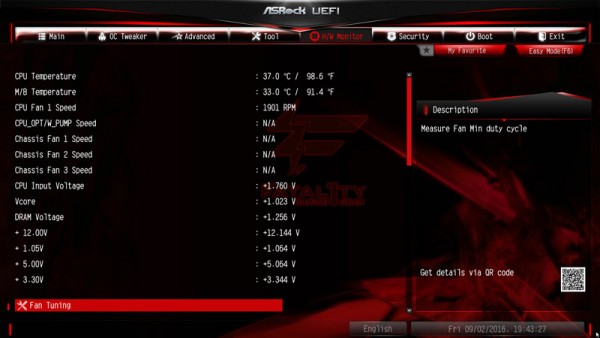
There are several interesting novelties: Firstly the chassis fans are now divided in CPU_OPT / W_Pump switch, there is now also a selection of time to raise and lower the fan speed and last but not least the motherboard chassis now automatically detects if a 4-pin fan or a 3-pin fan is connected at the 4-pin chassis fan connector and fits the type of control (PWM or analog) accordingly to – exemplary solved like with the X99 Taichi!
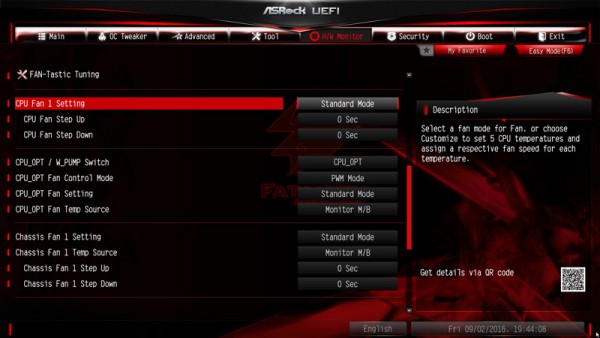
You have the choice between Customize, Silent, Standard, Performance and Full Speed. In Customize mode are several temperature steps to assign a certain fan speed.
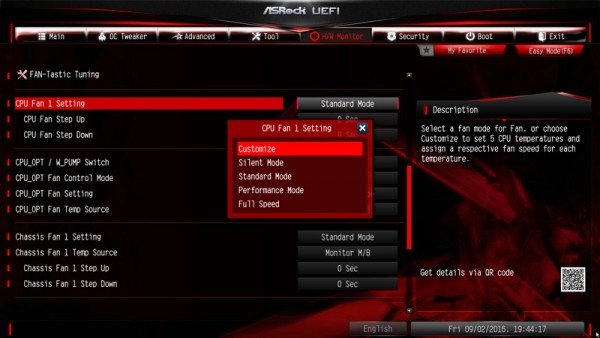
Here you see the settings of the fan controller and the time selection to increase or lower the fan speed.
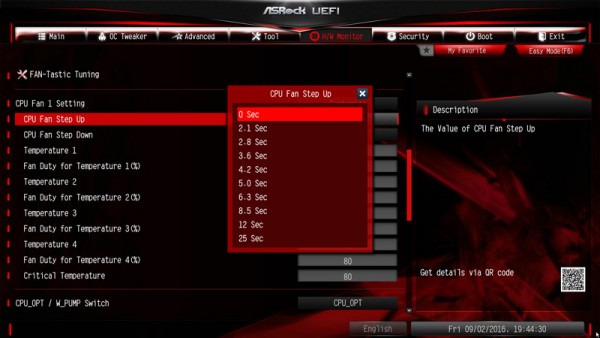
Since the announcement of X99 motherboards, ASRock has even implemented a graphical interface in the UEFI setup for controlling the fans. You can find the FAN-Tastic Tuning menu also in the H/W monitor and thus can make all the settings very clearly. Simply select the respective fan connector on the left and select the mode on the right side – e.g. Performance.
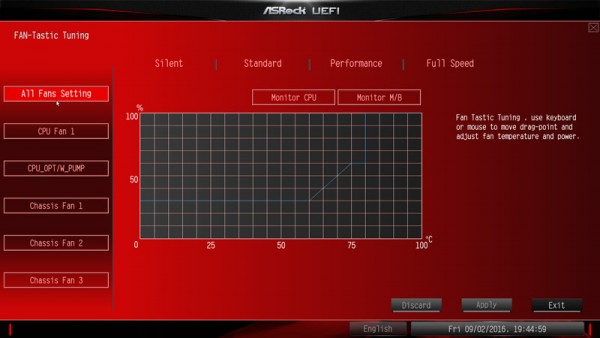
In Customize mode, you can set all values directly in the chart and save.
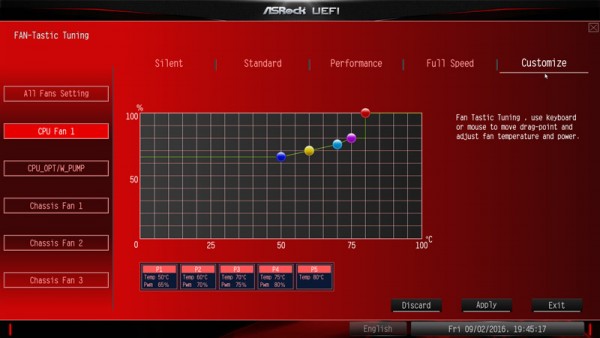
For the chassis fan connectors you can even select, which source you want to use for temperature measurement – Monitor CPU or Monitor Motherboard. Then click on apply and save the values.
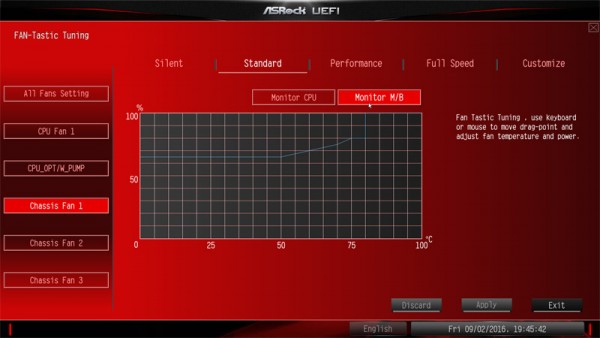
The fans are controlled with this fan control based on the CPU or the motherboard temperature, so you can usually get along without an expensive Fan Controller. Especially since all FAN-Tastic tuning values even can be set in Windows over the included F-Stream tool.
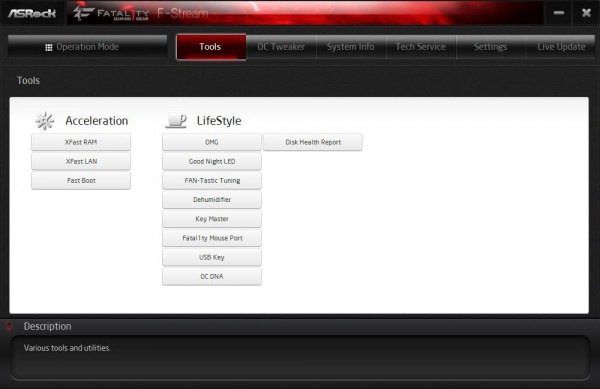
ASRock Fatal1ty X99 Professional Gaming i7 energy consumption …

